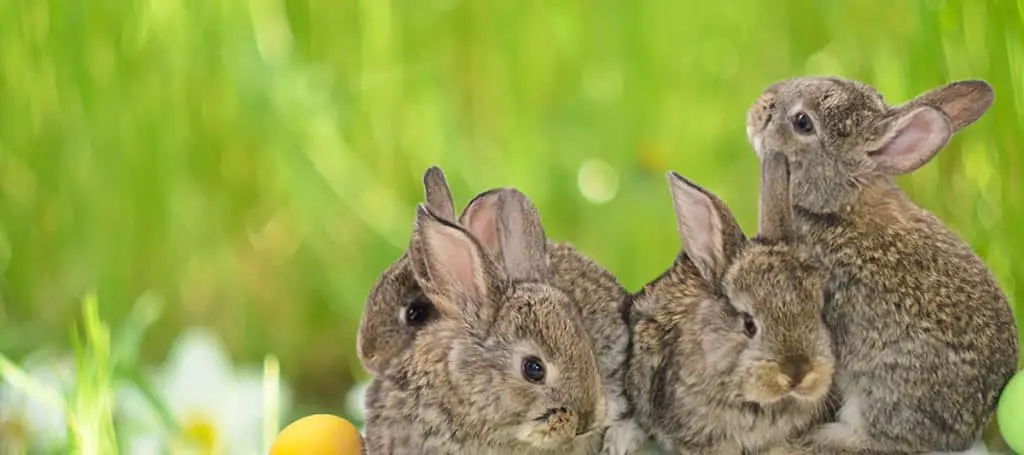Disclosure: We may earn money or products from the companies mentioned in this post.

If you’re going to keep rabbits as pets, you must know that they are known as rapid reproducers.
A female rabbit will have between 1 and 14 babies in a litter. On average a bunny has six baby rabbits per litter. The size of the litter depends on a number of factors including the age of the doe, the size of the doe, the health of the doe, and the rabbit’s environment.
Even more shocking, rabbits can get pregnant again within 24 hours of giving birth.
As you can see, rabbits can indeed “reproduce like rabbits”. To make things even more interesting, the mortality rate for baby rabbits is also pretty low in a domestic setting at less than 10%.
ProTip: A baby bunny is called a Kit.
The average number of surviving rabbits per litter can widely vary depending on a number of factors that we’ll discuss below.
Rabbit Size vs Litter Size
Litter size is a characteristic that will vary between various breeds of rabbits.
Larger breeds of rabbits have larger litters than dwarf rabbit breeds.
What Breeds Of Rabbits Have The Most Babies
The breeds of rabbits that produce the largest litters are:
- New Zealand Whites
- Flemish Giant Rabbit
- Checkered Giants.
These large rabbit breeds tend to have litters of up to 14 bunnies.
The smallest rabbits give birth to an average of just 2 kits
Medium-sized rabbits birth about 6 kits.
Litter Number and Average Litter Size
According to the University of Miami, the rabbit’s litter size can also vary according to the sequential number of litter; whether it’s first littler, second, or so on.
In general, the first little tends to be smaller, and then litters begin to grow larger as your doe (a female rabbit) reaches ideal maturity for motherhood.
Then as your rabbit ages, the litters will begin to get smaller until your doe reaches the end of her bunny-bearing years.
Baby Rabbit Survival Rate
The infant mortality rate of domestic rabbits tends to be very low, less than 10%
That said, it’s important to remember that baby rabbits are fragile. When they are born some babies are simply weaker than others. When that happens, sometimes a mother rabbit will choose to abandon that weaker bunny and focus her attention and milk on the stronger kits.
At its core, a rabbit’s drive is born entirely from the need for the species to survive. This might seem a bit harsh as it’s our nature to think that the weaker ones should be cared for equally, but rabbits’ nature always puts the survival of their species ahead of the survival of one.
Rabbits analyze the litter and differentiate between the stronger and weaker kits.
If a doe feels that some of the kits can survive better than others, she’ll prioritize them. That means that the kits born stronger have a good chance of getting more care and thus they grow up to be significantly larger and healthier than their smaller brothers and sisters.
So that you’re not surprised, if there are any stillborn bunnies in a nest, it is possible that the mother rabbit will eat the remains. It’s gross but natural. This is a natural instinct to protect the other bunnies from the predators as they can smell a stillborn rabbit and locate the whole family.
While you are going to be tempted to check the next of new baby bunnies immediately after birth and to remove any stillborn babies, you really need to not handle the babies for a least three weeks. For some new mothers, smelling different odors (yours) on the babies causes them to reject the kits. Just don’t risk it.
Some new mother rabbits will remove stillborn kits from the nest, and if you see this happen it’s perfectly ok to remove the body from the hutch.
Conclusion:
A single female rabbit will have between 1 to 14 rabbits in a litter, but the average number per litter is 6.
The litter size may vary from rabbit to rabbit and some babies may be born weaker than others.
Once your rabbit has given birth, it may be weeks before you get a really accurate count. It’s best to not handle the babies for at least three weeks.
When peeking into the next box, it’s often hard to see all of the babies as some will be buried deep in the hair and straw that makes up the next.
Regardless of the size of the litter, enjoy your baby bunnies!
